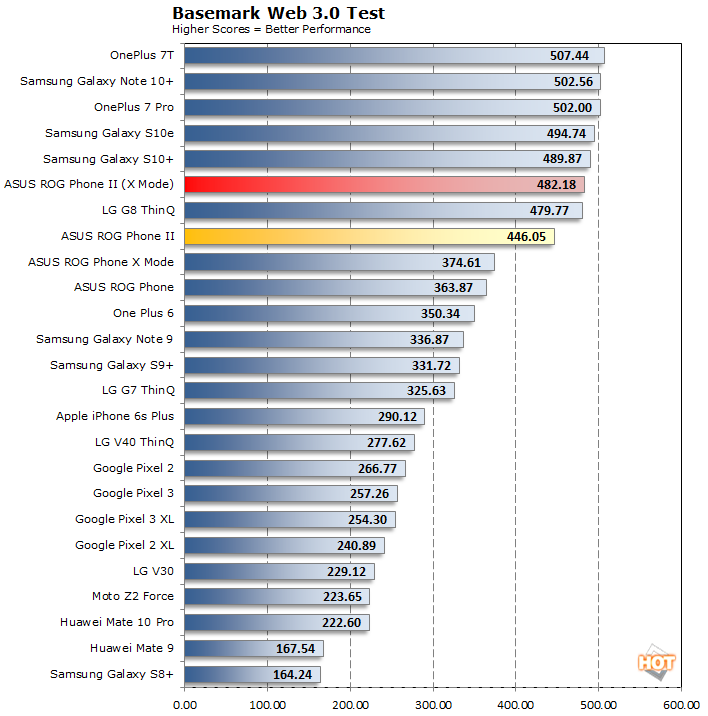For our firsts set of tests, we're using the JetStream benchmark to evaluate
Javascript performance and Basemark's Web Test 3.0 for a more comprehensive, mixed-media web performance analysis, which includes HTML5
rendering. Here we'll primarily determine how the ROG Phone II, with its 12GB of RAM and Snapdragon 855+ SoC, handles this specific workload with the Android Chrome web browser. All tests were performed at the phone's default resolution. Furthermore, we recorded two sets of benchmarks—one at the stock settings, and another with X Mode enabled. Note that X Mode does not overclock the CPU or GPU, but it does raise the minimum CPU frequency and performs other optimizations.
 |
|
JetStream And Basemark Web 3.0 |
| JavaScript and Browser Testing |
|


As we saw in our performance preview, the ROG Phone II leads the pack in the Jetstream benchmark, and that holds true whether X Mode is enabled or disabled. Things are a bit different in the Basemark Web 3.0 test, however, where the ROG Phone II slides a few pegs. It's a bit of a weird result considering the Snapdragon 855+ SoC inside, and we ran this test a whole bunch of times to ensure our initial average was not an outlier. While the ROG Phone II never led the way, it did mingle with the fastest phones of the bunch.
 |
|
GeekBench |
|
Synthetic CPU Benchmark |
|
In the GeekBench test, we're stressing only CPU cores in a handset (not graphics), with both single and multi-threaded workloads. The test is comprised of encryption processing, image compression, HTML5 parsing, physics calculations, and other general purpose compute processing.

The results shifted back in the ROG Phone II's favor in Geekbench, where the phone led every other Android device we have ever tested. And in X Mode, it even managed to pull ahead of the iPhone X in the multi-core portion of this test, while getting slightly edged out by the iPhone XS Max. The ROG Phone II also bested the
OnePlus 7T, the only other phone in our roundup of scores to wield a Snapdragon 855+ SoC.
 |
|
Futuremark PCMark For Android |
|
General Purpose Pocket Computing Performance Metrics |
|
Futuremark's PCMark for Android is an excellent suite of tests that we recommend for benchmarking performance of a handset in a wide range of tasks, for things like image and video editing, as well as lighter-duty, everyday workloads such as email and web browsing. When you see the test running live, it's clear the scripted application tests are carefully selected and tuned to make use of the mobile platforms involved in a very controlled way.
PCMark presents us with an interesting data comparison. Our rankings are sorted by the Overall score, and in doing so, there is a fairly large disparity between running the ROG Phone II in X Mode and turning off the performance tuning. That said, when enabling X Mode, the ROG Phone II is the fastest phone of the bunch. Also interesting to note is that its Photo Editing score is off the chart (literally) in X Mode.
 |
|
AnTuTu 7 |
|
Platform Benchmarks |
|
AnTuTu’s latest benchmark returns a number of metrics ranked with somewhat nebulous scores, rather than frame rates or time to complete. We tested with the latest version of AnTuTu across an all Android platform group. AnTuTu returns four top level performance metric results that we are including here: CPU, RAM, 3D, UX (or User Experience), along with a total score.

In AnTuTu, the OnePlus 7 manages to inch ahead of the ROG Phone II ever-so-slightly. They're virtually deadlocked with X Mode enabled, though, which is not surprising since they are using the same bolstered SoC.
















